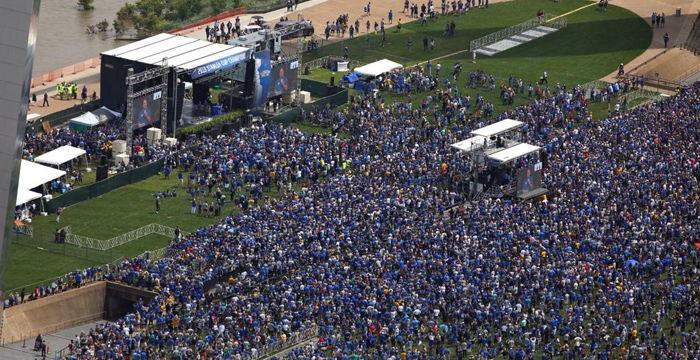January 29, 2020
Feeling the Blues As Fast as They Can
“We were talking with the Blues,” says Kyle Vogt of Klance Unlimited, located in St. Louis, “and we didn’t want to get too far ahead of ourselves and jinx it—we’re all superstitious.”
On the table was serious business: staging a potential victory event for the St. Louis Blues at the end of the Stanley Cup Playoffs. Klance United was ready to go. An experienced team with roughly a dozen Stageline stages and a variety of other hardware on offer, Klance is known across the Midwest and the country for its readiness to spring into action with a top-tier event.
(This wasn’t Stageline’s first major sports league celebration, either . We’re humbled to report our stages recently played a starring role in the Raptors victory celebrations in Toronto, as well as the Washington Capitals’ 2018 Stanley Cup celebration, the Chicago Cubs 2016 World Series party—and more.)
But that’s hard to get ready to spring into action when you’re so much of a Blues fan you worry making firm plans to mount a victory party might botch the whole playoff run—and the event along with it.
“We’ve been a part of Super Bowls before,” Vogt says, “and we’ve done Major League Baseball All-Star games in the past. But obviously, this being from our home city, we were all into it, and spirit was high. We’ve done a lot of major events as far as sporting events, of course, but this one, obviously—what with St. Louis not having had a championship, that got everything really hyped up.”
Vogt and Klance United had some practice—they worked with the NHL to stage watch-parties outside the Enterprise Center, employing an SL-320 with wings and video platforms on a stage headlined by Nikko Smith for Game One and Gary Clark Jr before Game Two. For complicated reasons, Vogt says, once the games themselves left St. Louis, the NHL “didn’t have the appetite or the budget” to continue mounting outdoor events for the series. That left Klance to plan with the Blues, the St. Louis Sports Commission, and the City of St. Louis to plan for an event that the whole city could come to.
They got it: though the stage for their Game Six watch party was scaled down to the smaller SL-260, they increased their screens, which they distributed all over.
“They estimated 40,000 people, but security told me it was probably more like 75,000—they just didn’t want to alarm the fire department,” Vogt says with a hearty laugh.
That left Game Seven, and a group of fervent Blues fans trying to plan a potential celebration without presuming their team was going to win.
“We did some discussion about if there was going to be a parade,” Vogt says. “At the end of game seven, we already had a plan for if they won. The first steps would be we had a load-in scheduled for 7am the next day. Not necessarily the stages to be there at 7am, but we brought in the fencing, the bike racks, so we could go ahead with our site crews and get them started getting the area secure.”
There was a bit of luck in the location, as the Klance team is familiar with setting up at the St. Louis Arch from its annual Fair St. Louis.
“We usually use the SAM550 down there. We kind of have a template to follow. But it normally takes us a week to load in. It’s a challenge just to get trucks in and out of there. They have roads to get in, but they weren’t designed for 53′ semis. It’s a bit of a slower process. We had 48 hours of planning, and about 48 hours to get it all together.”
The real catch is security, because the St. Louis Arch is a tightly guarded federal park. Every person who would be doing so much as driving a truck onto the site would have to pass a security screening.
“Going through Park Security and getting background checks for everybody, that’s what takes up a lot of time,” he says. “Until they say you can go in, that’s how long it takes.”
But things moved quickly ahead. The stage arrived around nine and they spent an hour positioning it before bringing their stagehand in at 10am. They budgeted a little extra time for the newer SL-320’s wind-wall system, but by four o’clock they signalled production to begin their work.
“By 10pm, we had sound, light, and video pretty much up and ready,” he says. “We also had our SL100 mix as front-of-house. That worked out well: we put some local TV camera crews up there to get some shots of the stage. By 10pm we had the core of it ready to go. We also brought in trailer-mounted LED screens from Go Vision, and more LED platforms to build throughout there. There were three more big screens we had to build, and we needed to put in audio-delay towers throughout the area.” But they were ready for the next day. The crowd, when it came was a half a million people.
“I was glad we had some of our newer stages in town to do that. They looked really sharp. The banners worked out well,” Vogt says. “Plus I couldn’t be more proud of our guys for how they performed. They really brought their A-game. Thankfully, the mobile stages from Stagelines really helped us out a lot as well.”

